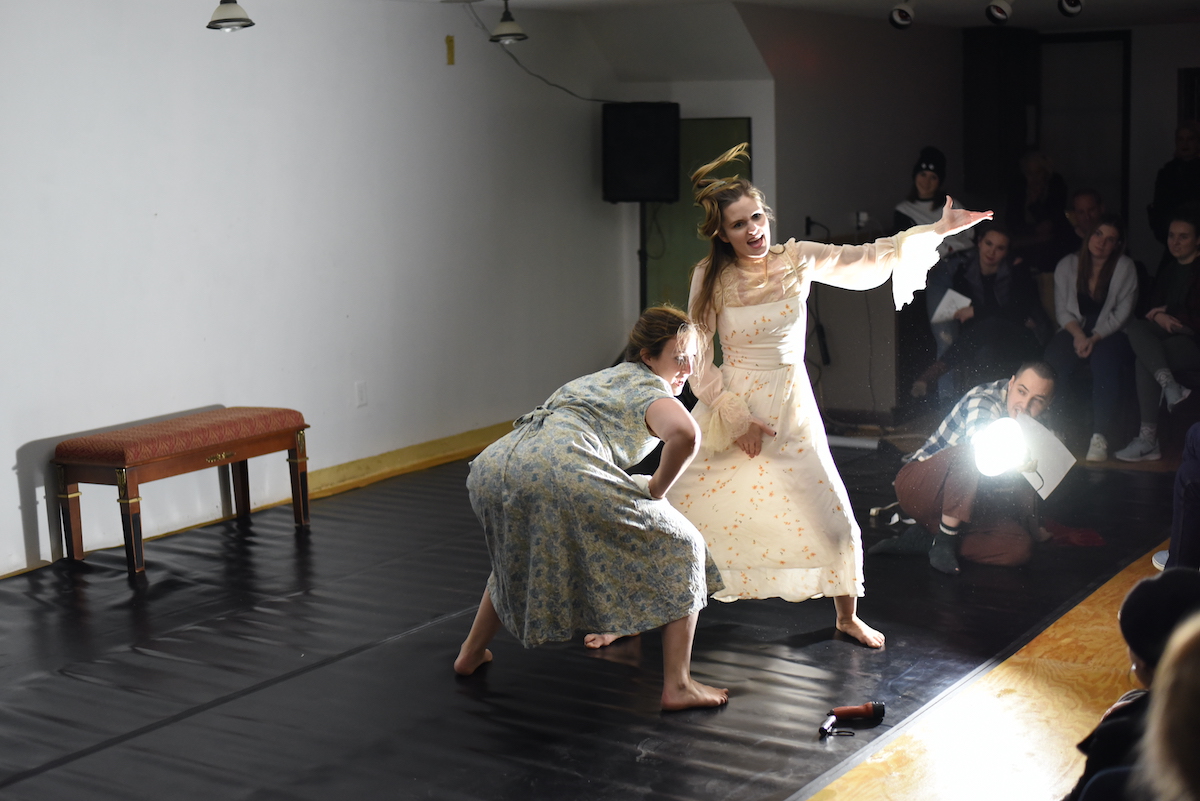Kayt MacMaster and Rachel Rizzuto huddle together under a sheet, telling stories of fifth century B.C. debauchery by flashlight. MacMaster lays on her back. Rizzuto wraps the sheet around her waist and straddles MacMaster who occasionally pops out from beneath the makeshift skirt to bark a blunt declaration about dicks. Many dicks.
Anarchy ensues as the pair rope the unsuspecting audience into a singalong about the 415 B.C. desecration of the herms—rectangular Athenian statues with genitals. Spurred on by the live keyboard stylings of Jacob Henss, the audience members shake with uncontrollable laughter as they shout-sing:
“Need a mallet and a chisel to make this phallus fizzle, ’cause it’s dick-chopping time!”
“Please Don’t Pet Me, I’m Working,” the third work in RADFest’s Saturday evening of short works, stands out for its raunchy entertainment value, brazen theatricality and well-timed audience engagement. Far from helpmate or man’s best friend—as snarkily indicated by the title of the work—MacMater and Rizzuto stand in allegiance with the confidants, co-conspirators, witches, teases and rebellious wives of history. The performers gossip, cackle, march and chant their way through a lecture in patriarchal dismemberment, colorfully embellished through a host of unsubtle powerpoint slides including a video of a mouse trap chopping off a meaty hot dog tip in slow motion.
While the dance may not be able to conclusively answer who was responsible for the desecration of the herms, one thing is for certain: It’s Saturday night in Kalamazoo and 150 adults have just collectively carried out one massive dick joke orchestrated by two women in vintage dresses. I have never felt so proud to be a lady.
Feminism also takes a central role in Li Chiao-Ping’s feral-chic trio, “Nuts and Bolts.” Clad in red ball gowns embellished with ruching and puffed sleeves, Piper Morgan Hayes, Cassie Last and Elisabeth Roskopf creep along the downstage right diagonal with linked arms. Their high-kneed, flex footed walk gives the impression of a giant praying mantis on the hunt. They prowl, weaving in and out of each other as they snack on imaginary insects groomed from one another’s backs. Hayes and Last grab a reclining Roskopf by the wrists and ankles. They swing her in a full circle. The audience gasps as Roskopf arches at the apex of the swing, the momentum of her return rocketing her dangerously close to the floor.
“E Pluribus Unum,” the closing act of the evening, unites 10 recruits on the battlefield after questions of conformity arise during training. The platoon skips forward, eyes locked ahead. All but one member carries out the marching orders with exactitude. Standing in a horizontal line downstage, the group cranes over the rogue soldier, leaning into her until she hinges backward all the way to the floor. The remaining nine swing, breathe, jump and shake together, their tight ranks seemingly impenetrable to the ousted soldier. While the army green costuming, linear marching and trope of the lone soloist shunned for her individuality reinforce the dance’s title too literally for my liking, I can see how these same features might serve as essential anchor points for general audiences who may otherwise be turned off by the obscurity of contemporary dance. Choreographer Liz Dibble has a strong sense of movement craftsmanship—anyone who can choreograph militant skipping and have it look intelligent clearly knows what she’s doing. I am interested in seeing if her other work allows her evident musicality, gesture invention and group phrasing to shine through without being overpowered by subject matter. Audrey Allen, Joey Anderson, Kyla Balser, Julia Izu, McCall McClellan, Emma Seegmiller, Keli Shinsanto, Bailey Smith and Spencer Waddell dance with notable cohesion. Their teamwork clearly extends beyond the stage.
The program’s two opening solos, Leslie Dworkin’s “Undertow” and Jacob Regan’s “A Fork Dancing With A Hammer,” both rely heavily on improvisation. Offering distinct movement signatures—Dworkin patient and expansive, Regan explosive and athletic—the two performers round out an eclectic evening of dance.
I’ve seen the latter four times and love its jam packed brevity (full disclosure: Regan is my partner). The RADFest audience seems to love it too. Exclamations of “How’d he do that?!” “Teach me!” and “I wonder where he’s from” pepper the applause as Regan’s spotlight clicks out.
Dworkin calmly rides the current of “Undertow,” activating the detritus of imagination with curiosity and care. She folds at the waist, grazing the tips of her toes lightly across the floor as she pulls herself along a dimly lit downstage corridor. She crosses her forearms to mask her face, then peels her wingspan open before walking with measured steps as if balancing on a tightrope. Facing the audience, she delicately passes something invisible and soft back and forth between her hands. She stirs the air from her shoulders and vigorously shakes her wrists. Dworkin is a master of texture. She calls upon the airiness of sweeping and the clutter of a collapse. While competing, metaphoric poles may rage below her, Dworkin finds harmony in the divergence. She mediates the opposing tides.
—
A virtual encore of all four RADFest professional series programs and the youth showcase will be available for online audiences March 10-12. Tickets at midwestradfest.org.
